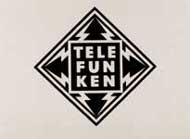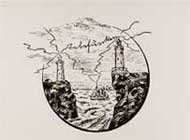Receiver KWE-a or LWE-aA view inside the receiver. Very well visible are the tubes
RV2P800 in there sockets. Right is shown the 2
gasfilled bulbs for protecting the HF-input. Very high voltages due to
lightning in heavy thunderstorms are fed back then through them to earth. The
various coil sets for the several frequency bands above right are turned
around via a kind of "Maltheser Kreuz" principle. When it begins turning, the
contacts are lifted (open contacts), then the coil set turnes to its position,
stops turning and after that the contacts are closing again. In this way the
contacts are kept pure and clean.
This is a master piece which has put a technical standard that, in my
opinion, was the world's best battery tube powered communication
receiver for that freq. range; if you imagine that is was designed (I
suppose) 1936-1938. Not only the mechanical construction, but the
circuit design as well were outstanding (advanced). Look for example the
design of the IF stages with the band width selection control and/or the
separate AVC (AGR) amplifier among many other things. This technical
effort is in my opinion quite under valued, from the technical point of
view it isn't important that an item (artefact) is too expensive to be
produced compared to similar Allied artefacts.
Regenerative receivers were an exception (I mean super-regenerative,
not straight forward receivers, because the TornE-b and/or Lo 6 K 39
were very good, although no super heterodyne), these were used only for
small portable sets But the British used this same principle for the
B-set of the WS 19 as well.
The major difference between receiver standards from Europe and the
US were for the latter that they were using tubes extensively (quantity)
which, caused by economical factors, wasn't possible in Europe. US
communication receivers often used twice the number of tubes as these
were utilised in Germany, Holland and Britain. An other important factor
which is often neglected is the fact that the Germans were very well
orientated on what was going on in the US and many US articles and
publications were discussed by them. Probably because so many German
scientist were immigrated to the US and some still had links to Germany
kept alive.
E52b Køln
 Attenuation De-Tuning
Bandwidth Wide
Bandwidth Narrow
Attenuation De-Tuning
Bandwidth Wide
Bandwidth Narrow
3 db
5 kHz
0.2 kHz
40 db
10 kHz
1 kHz
60 db
13 Khz
2 kHz
You get a first impression from it by looking at the two hinging lids
that are lifted to show some of the gadgets under them when they are
normally closed. You probably notice the clean layout of the front panel
and the functional shape of the controls. And that was done in the days
that "ergonomics' was an unknown word.
The dimensions of the radio are 24.1 cm high, 44.6 cm wide and 36.9 cm
deep. Its mass is a massive 42.8 kg (94 lbs.). The set can be run from
110-230 V. a.c., from which 60-96 watts are consumed, or from a 12 V.
battery. A vibrator power supply is built in.
There are five frequency ranges, as follows:
(Range I ) 1.5-3 MHz, white scale on the dial.
( Range II ) 3-6 MHz, red scale.
( Range III ) 6-10 MHz, yellow scale.
( Range IV ) 10-17.6 MHz, blue scale.
( Range V ) 17.6-25 MHz, green scale.
The ranges are selected by the oblong control to the left of the
indication 'FrequenzeI.nstellung" (frequency adjustment). The frequency
the radio is tuned to can be read from the semicircular dial. To avoid
reading the wrong scale the frequency ranges are tabulated to the left
of the dial and the table also shows the colour of the scale to be read.
Tonschreiber d (Dora)
AEG Magnetophone
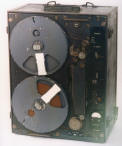 Frequency: 50-6000hz. Bandspeed 77cm/s.Roller capacity 10min.Factory
AEG. in berlin.Produced 1941 but product started 1940/41. Color
military green until 1943.1943 to 1945 antracit.5 batteries 2,4v NC-28
in serie and vibrator power.
Frequency: 50-6000hz. Bandspeed 77cm/s.Roller capacity 10min.Factory
AEG. in berlin.Produced 1941 but product started 1940/41. Color
military green until 1943.1943 to 1945 antracit.5 batteries 2,4v NC-28
in serie and vibrator power.
Tonschreiber c (Cesar)
 Frequency: 200-2000hz. Bandspeed 19cm/s.Roller capacity 11min.factory
AEG
in Berlin.Produced 1941.Color military green until 1943,thereafter
antracit. Powering the unit with steel-spring mecanism and 4.5 v dry
battery for microfon and band .Steel-spring driving the
band-motor.Weight ca 12kg. The band was made of 6.5mm
Azetylcellulosefilm
Frequency: 200-2000hz. Bandspeed 19cm/s.Roller capacity 11min.factory
AEG
in Berlin.Produced 1941.Color military green until 1943,thereafter
antracit. Powering the unit with steel-spring mecanism and 4.5 v dry
battery for microfon and band .Steel-spring driving the
band-motor.Weight ca 12kg. The band was made of 6.5mm
Azetylcellulosefilm
Tonschreiber Ton S.b1
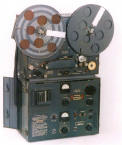 Freqency 60 -5000hz.bandspeed 9-120cm/s.Producer AEG.Berlin 1939.Color
antracit.Power 110 to 250v ac.Tubes: 7 RV12P2000, 2 LS50,1 Glimmtube
UR110. Weight 61kg.
Freqency 60 -5000hz.bandspeed 9-120cm/s.Producer AEG.Berlin 1939.Color
antracit.Power 110 to 250v ac.Tubes: 7 RV12P2000, 2 LS50,1 Glimmtube
UR110. Weight 61kg.






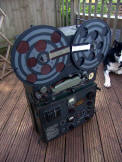




 Pic from
S.E.Blacklock
Pic from
S.E.Blacklock
The
Germans led the efforts to improve magnetic recording.
AEG developed the Magnetophone, and improvements in the chemical
engineering of polymers allowed its partner BASF to ship the first
magnetic tape in 1935 — a foil of cellulose acetate coated with a
lacquer of iron oxide bound with additional cellulose acetate. Most
developed nations continued to work on magnetic tape for commercial and,
with the approach of World War II, military applications.During the War,
the Allies became aware of the German superiority in this technology. As
U.S. forces advanced late in the war, a young technician from the Army
Signal Corps, John T. “Jack” Mullin, was assigned to capture and analyze
enemy radio equipment. He stumbled upon an advanced Magnetophone, and
U.S. work soon progressed in this area.According to one popular story,
in 1945, General Dwight D. Eisenhower wanted to record a message to the
German people, which he did using captured German tape. However, the
tape had not been completely erased, and Hitler’s voice, so the story
goes, could be heard intermittently along with that of Eisenhower.
Eisenhower ordered that no more captured tape could be used, and ordered
Major John Herbert Orr to use captured German scientists to set up an
American tape manufacturing facility.Afterwards, Orr returned to
civilian life in the United States where he went into partnership with
Alexander Poniatoff. Their company — Ampex — began producing magnetic
tape and magnetic recorders (German patent rights on the recorders had
been seized by the U.S. Alien Property Custodian).Meanwhile, Mullin had
also returned from the War, and in 1946 demonstrated the advanced
Magnetophone to a meeting of the IRE, predecessor to the IEEE. There,
according to Mullin's own account, it created quite a sensation.
Word got back to Bing Crosby, who was a pioneer in the area of
entertainer-as-entrepreneur (think Oprah Winfrey today). With Mullin as
a consultant, Crosby began to use the Magnetophone to record his radio
programs. Soon Mullin entered an arrangement with Ampex to supply the
equipment and recording medium, and the company and the technology took
off.The full Bing Crosby story will make for a good “Engineering & Pop
Culture” piece in this space some day. The important fact is that
magnetic tape became a crucial recording medium for the birth of the
information age, used for video as well as audio, in formats such as
cassette and 8-track, for sound recording in motion pictures (replacing
optical sound tracks), and eventually for digital recording, including
computer memory.There were many other players around the world: 3M in
the United States; a reformed BASF in Germany, Philips in the
Netherlands; and Sony in Japan. Ampex always remained a leader, and in
1995, Ampex successfully spun off its media division as Quantegy. Over
the past few decades, digital recording has all but completely
supplanted analog recording. Various new media, including those that
employ lasers, are now more widely used to record digital signals.
Although magnetic tape will continue to be used for niche applications,
it is no longer as ubiquitous as it once was. We tip our hat to
Quantegy and the closing of another chapter in electrical history.
Nahfeldhpeiler P.57n
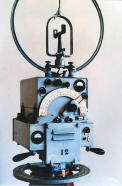
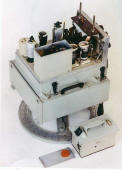 Frequence 3.0 to 20 Mhz, mod A1-A3.Producer
Telefunken.berlin.In war ca
1941.Constructed 1935.Color,marine blue.Constructed for moving
army.police and airports.This unit was mounted in special cars.Battery 4
x 4.8v NC10 and anode battery 150v Pertrix type 307.Tubes: 1 RE084, 3
RE084K and 2 RES094.IF-968khz.
Frequence 3.0 to 20 Mhz, mod A1-A3.Producer
Telefunken.berlin.In war ca
1941.Constructed 1935.Color,marine blue.Constructed for moving
army.police and airports.This unit was mounted in special cars.Battery 4
x 4.8v NC10 and anode battery 150v Pertrix type 307.Tubes: 1 RE084, 3
RE084K and 2 RES094.IF-968khz.
This site was last updated
01/04/10 Home
.





 Here is the cheme to power unit for
Kwea/Lwea.Soon the picture of the unit.
Here is the cheme to power unit for
Kwea/Lwea.Soon the picture of the unit.